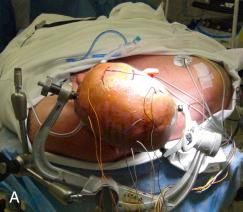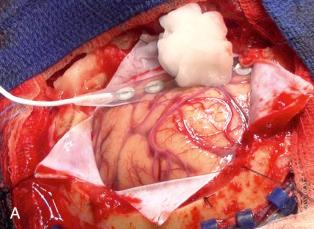Physical Address
304 North Cardinal St.
Dorchester Center, MA 02124
Intra-axial lesions are located in close proximity to the motor cortex (rolandic and perirolandic regions including the supplementary motor area). The infiltrative rather displacing nature of gliomas makes this approach suitable for low-grade gliomas (astrocytoma, oligoastrocytoma or oligodendrogliomas) and high-grade gliomas.
Non-cooperative patient because of disease or psychosocial issues.
Inability to follow commands or to reproduce the motor tests in the preoperative training, including motor weakness.
Anticipation of airway compromise during the awake portion of the procedure (e.g. morbid obesity, medically intractable seizures, or sleep apnea).
Comorbidities that could promote brain herniation through the craniotomy window (e.g. anticipated intracranial hypertension).
MRI with contrast, functional MRI (fMRI) and diffuse tensor imaging (DTI) are useful for surgical planning and to help localize the eloquent areas preoperatively. If these tests indicate that the lesion is involving functional motor cortex or is adjacent to it, an awake craniotomy with intraoperative motor mapping is typically advocated.
Preoperative structural CT and MRI scans can be fused with fMRI and/or DTI for intraoperative surgical neuronavigation. This can aid the initial parts of cortical mapping in such a way that the surgeon has a general idea where the eloquent areas are found.
Real-time clinical feedback from cortical and subcortical stimulation during the tumor resection allows a more precise localization of the eloquent motor areas and subcortical tracts than can be achieved with a preoperative MRI or fMRI. This can help achieve a maximal extent of resection taking into account the highly functional regions while limiting the functional damage to the patient.
The goals of intraoperative motor mapping are:
Delineation of essential functional and non-functional areas to maximize tumor resection thus improving long-term survival.
To minimize functional impairment of eloquent areas.
Although intraoperative monitoring requires further study to improve the set of paradigms used, this procedure can be standardized and used systematically in selected patients.
The use of short-acting/rapidly cleared anesthetic agents may allow more accurate early intraoperative neurological evaluation.
Systematic preoperative neurocognitive assessment is recommended.
Patient positioning as well as surgical setup in the operating room (OR) may be adjusted to provide safe access to the patient and allow mobility of upper and lower extremities. Patient anxiety and/or claustrophobia are taken into account.
Regions of interest: Primary motor area (precentral gyrus, Brodmann area 4), premotor area (frontal lobe, anterior to the primary motor cortex), supplementary motor area (medial region of the frontal lobe anterior to the primary motor area and superior to the cingulate sulcus in Brodmann area 6), Broca's area (pars triangularis and opercularis of the inferior frontal gyrus [IFG]).
Behavioral tasks (paradigms): Finger tapping, picture naming, digit span, Regensburg word fluency test and spontaneous speech, spontaneous simple movements and complex movements.
The surgery can be done by a sleep–awake–sleep craniotomy (SAS) ( Figure 2.1A–D ). It requires a smooth transition between sedation and consciousness. In this variant the patient is initially administered intravenous anesthesia and regional anesthesia with slight sedation with propofol plus fentanyl or dexmedetomidine with intubation or with laryngeal airway. The challenge of this variation is repeated intubation.

The patient can be ventilated via a nasotracheal tube throughout the procedure or with a laryngeal mask that may be removed when the patient is awakened.
The patient will be sedated from the positioning time to the dural exposure with continuous monitoring with BIS (bispectral index) or entropy to control the moment of awakening. The patient is woken before the dural opening to perform several tasks during brain mapping and tumor resection. After tumor resection has been completed the patient is sedated for dural, bone and scalp closure.
This surgery can also be performed through an awake–awake–awake craniotomy (AAA) where the patient is awake for the entire duration of the surgical intervention with optional periods of conscious sedation.
Local anesthesia or segmental nerve blockade is used bilaterally, especially at the incision site and at the pin sites of the Mayfield holder.
When mannitol is needed, a dose of 0.5–1.0 g/kg is administered. Alternative options to decrease brain edema are steroids and hypertonic solutions.
Body temperature should be maintained at about 36–37 °C. Patient shivering because of cooler temperatures make it difficult to effectively perform motor mapping.
Possible adverse effects caused by electrical stimulation are induced seizures and edema.
The major complaints during the awake portion are neck pain and stiffness, restlessness and dry mouth. These can be alleviated with good positioning, water-soaked sponges and slight changes in position of the arms and legs.
Intraoperative neurophysiological monitoring electrodes are placed around the craniotomy site ( Figure 2.2 ).

Intraoperative monitoring includes:
Continuous electroencephalogram (EEG): scalp electrodes. Can detect general cerebral activity and differentiation of patient arousal: sleep (periodic) vs. awake (continuous).
Continuous multichannel electromyography (EMG): paired subcutaneous electrodes at the target muscles. Can detect subtle motor responses that may not be evident clinically. This is particularly important in the subcortical stimulation of white matter fiber tracts.
Electrocorticography (ECoG): cortical strip electrode. Can detect the general status of cortical surface, working current, afterdischarges (AD), organized spikes (early detection of induced seizures) and electrical seizures ( Figure 2.3 ).

MEPs (motor evoked potentials) and SSEP (somatosensory evoked potentials) are not typically performed because of patient discomfort during awake motor mapping.
After the dura is opened and the cortical surface is exposed, cortical function mapping with Ojemann stimulation is initiated.
For the EcoG the 1×8 electrode strip is placed on the cortical surface adjacent to the stimulus delivery site and the cortical activity is recorded in a bipolar manner using seven channels.
The stimulation starts monitoring with ECoG. EcoG will alert the surgeon to any AD that might be elicited by direct cortical stimulation. Current starts at 2 mA and is increased by 0.5 mA after several areas are tested without evoking AD. Typically, 6 mA is not exceeded. If AD are elicited during intraoperative mapping: 1, have in mind that they can alter your clinical assessment; 2, consider stopping stimulation; 3, prevent their recurrence by adjusting stimulation intensity, or avoiding further stimulation in that specific region. If AD continue, ice cold irrigation or anesthetic agents such a as propofol can be used.
Early detection of spikes in the ECoG recording may precede an induced electrical seizure.
Become a Clinical Tree membership for Full access and enjoy Unlimited articles
If you are a member. Log in here